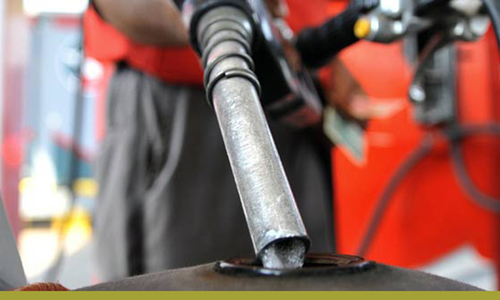NO one in his wildest imagination could have fancied a barrel of Brent crude price to tumble from $115 in June 2014 to $29.44 last Friday — a matter of a little over a year and a half. But it has happened and the price of oil has sunk to a 13-year low.
According to Khurram Schehzad, director research and investment strategy at brokerage Arif Habib Limited, a drop of a dollar in price of oil should lead to benefit of roughly $150m to the country. Back of the envelope calculation by this writer suggests that going by that assumption, a slump of $90 in crude in around 18 months should translate in a windfall of $13.5bn or a whopping sum of Rs1.42 trillion. Leaving one to that spell-binding figure, an assessment of oil price slump on equities would be of value.
As oil is the basic fuel that turns the wheels of industry, most sectors listed on the Pakistan Stock Exchange (PSX) are the beneficiary of freefall of its price. Independent Power Producers (IPPs) are one of the principal gainers as cheaper Furnace Oil (FO) supplies ought to reduce their cost of power generation.
The fall in crude prices has been a blessing for the economy
“Every $10 per barrel reduction in oil price would translate into a potential Re0.60/kWh reduction in the generation cost”, an energy analyst said. Several FO-based IPOs were converting to gas-fired or coal-based plants. However, an analyst argued that since most IPPs were operating on an internal rate of return (IRR) of 17-18pc, the government absorbs losses when oil prices were rising; so it would pocket gains when the prices were on the slope. “The IPPs operating on ‘pass through’ formula would definitely reap rewards”, he admitted.
Analyst Rajesh Kumar Maheshwari at Standard Securities reckoned that automobile sector will enjoy the fruits of lower oil price as together with the depreciating Japanese yen, decreased oil price would reduce operational cost of auto assemblers. With decrease in fuel prices, the cost of operational activities would also drop in the highly leveraged cement industry. Textile sector benefits from improvement in margins due to decrease in prices of electricity and receding interest rates. Chemical and paint producers would gain from reduced cost of chemicals—the basic raw materials which have direct relationship with oil prices.
But the steep decline in oil prices has sent shivers up the spine of energy sector investors. The stocks on oil and gas exploration and production companies (E&P) and Oil marketing companies (OMCs) have been the favourites of foreign and local deep pocket individuals. But those two sectors have been badly bruised.
While the E&P companies are taking a hit on their revenues as their pricing formula is based on the Arab Light, the oil marketing companies (OMCs) are incurring heavy inventory losses as oil price per barrel continues to slip. The stock prices of heavyweight OGDC and PPL closed at 6-year low on Thursday.
Some sector watchers believe that one blessing of falling oil could be the cut in circular debts across the energy chain, but whether that has happened is yet to be seen in the latest financial figures of companies as they arrive in February. Meanwhile, the sales volume of petroleum products by OMCs for 1HFY16 (July-Dec) has increased by 4pc. “This volumetric growth and likely decrease in circular debt could tide over some of the inventory losses by OMC”, suggests an oil expert.
But keeping the woes of investors in energy stocks aside for a moment, the government as expected is seen to be jumping with joy. The fall in crude prices has been a blessing for the economy. As oil imports constitute 30pc of country’s total imports, it has salutary effect on the import bill and the country’s balance of payments position. It ought to have translated in steep drop in import of petroleum products and crude. It should also have helped reduced subsidies and circular debts.
The other day Mohammad Zubair, minister of state for Privatisation, boasted about the PML government’s several achievements which included inflation which was recorded at 3.2pc for the six months, providing room to SBP to slash discount rates and automobile sales which registered growth of 32pc.
One analyst recognised the benefits of slide in oil prices as reserves had ballooned; inflation had receded; interest rates had dropped; import of machinery had improved and number of registered companies during 2015 had mounted to 80,000. All those indicators were considerably higher for the first time since 2008.
“If sale of trucks have increased, it means there is more goods and machinery to be transported, which is a sign of growth”, he suggested. Workers’ remittances in first half of this fiscal year have so far registered growth of 6.26pc over same time last year, though there are risks of slowdown in remittances if jobs in Gulf countries are lost due to oil being on the slippery slope.
Yet consumers are sour. They believe that the entire God-sent windfall in record low oil prices has been utilised by the government to tide over its own financials with precious little benefit passed on to the masses. The impact is not noticeable in proportionate decrease in prices of petroleum products; electricity charges; transportation costs and food prices.
Many economists on the international scene wonder if the worst for oil prices was yet to come. Morgan Stanley reckoned last week that oil could touch $20 per barrel while the Royal Bank of Scotland (RBS) warned that if it falls below $30, then $16 was on the horizon. “This terrible cocktail means investors should now be thinking about getting a “return of capital, not return on capital”, RBS suggested.
Published in Dawn, Business & Finance weekly, January 18th, 2016













































